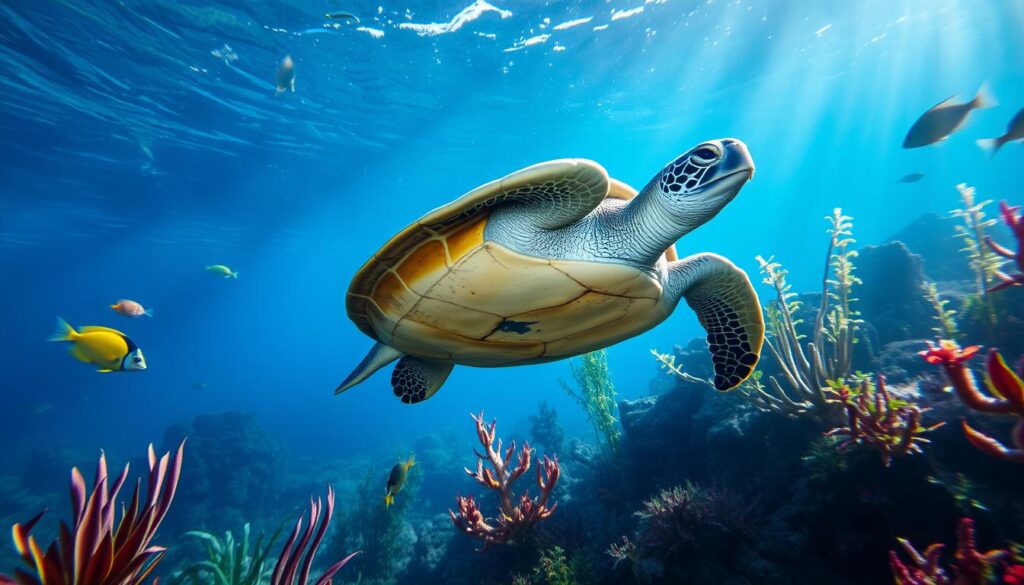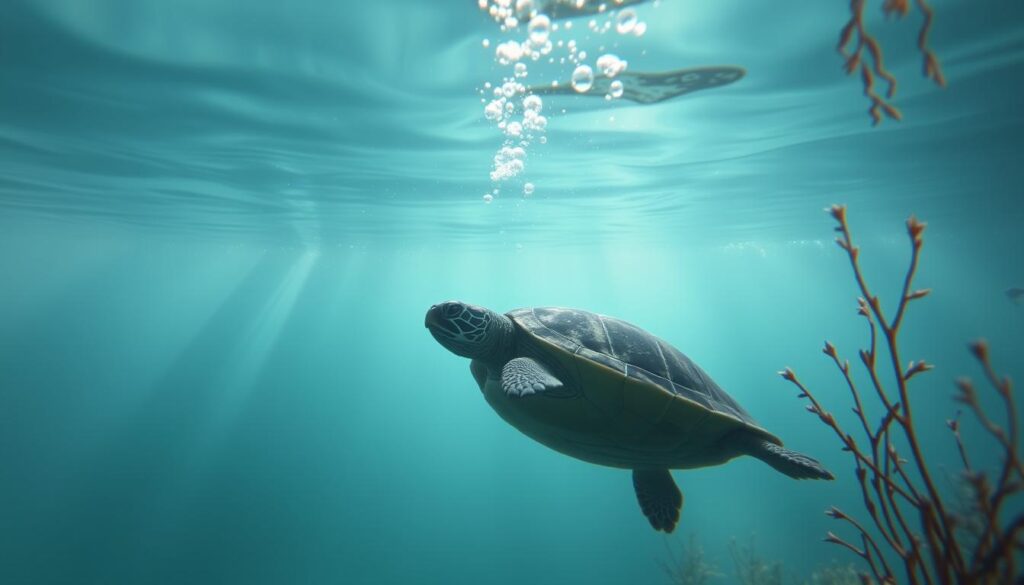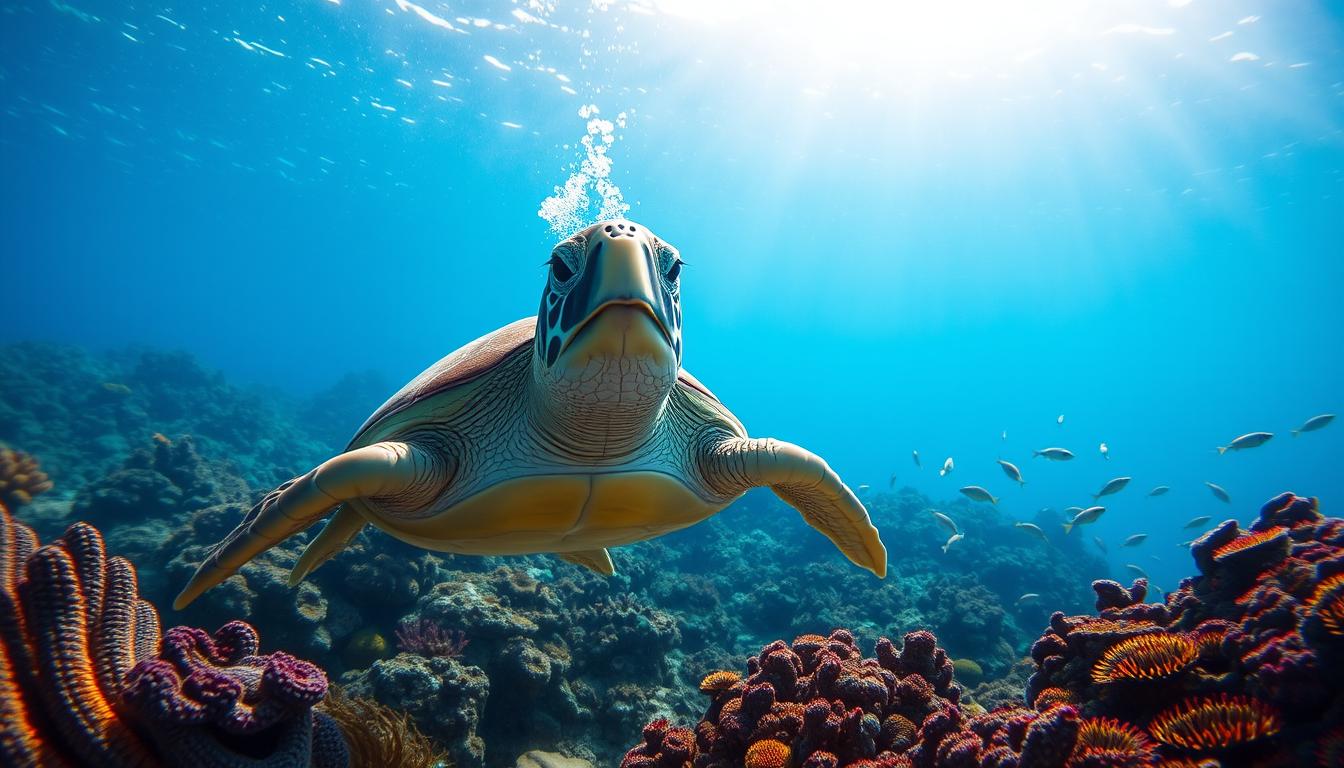Ever wonder how turtles stay underwater for hours? They are amazing creatures with a special way of breathing. Let’s explore how turtles breathe and what makes them so unique.
Turtles are ectotherms, meaning their body temperature changes with their surroundings. Unlike humans, who keep a steady body temperature, turtles’ bodies adjust to the environment. This affects how they breathe and survive in water and on land.
Table of Contents
Understanding Turtle Respiration Basics
Turtles are fascinating reptiles with a special breathing system. They can live on land and in water. Their lungs are key to their breathing. Unlike mammals, turtles don’t have flexible ribs or a diaphragm. Instead, they use muscles in their belly to breathe.
The Role of Lungs in Turtle Breathing
Turtles’ lungs are essential for breathing. They take in air through their nostrils, or nares, above their mouths. Some turtles also use their cloaca to get more oxygen from water.
Different Types of Turtle Breathing Methods
- Terrestrial box turtles can hold their breath for a few minutes underwater.
- Aquatic species like the painted turtle can stay submerged for up to seven hours.
- Turtles do not have gills; they rely on their cloacal respiration to absorb oxygen from water into their bloodstream.
Anatomy of Turtle Respiratory System
The turtle respiratory system is complex. It includes lungs, nares, and special parts for breathing through their cloaca. Turtles have slow metabolisms and can survive without oxygen for a while. This helps them live in both water and on land.
| Turtle Species | Maximum Underwater Survival Time |
|---|---|
| Terrestrial Box Turtles | A few minutes |
| Painted Turtles | Up to seven hours |
| Sea Turtles | Up to 11 hours of underwater sleep |
“Turtles have evolved adaptations such as slow metabolism, cloacal respiration, and anoxic tolerance to thrive in both aquatic and terrestrial environments.”
Do Turtles Breathe Underwater?
Turtles can’t breathe underwater like humans do, but they have special ways to stay under for a long time. They can take in oxygen through their skin and a special opening called the cloaca. This lets them stay underwater longer than they could without it.
This method, called cloacal respiration, isn’t the same as breathing. But it helps turtles stay under for longer. Humans can hold their breath for up to 24 minutes, but turtles can do it for hours.
Sea turtles, for example, can hold their breath for hours. They do this while looking for food, avoiding danger, and even sleeping. The longest time a sea turtle stayed under was 7 hours in Greece.
- Sea turtles usually dive for 20 to 40 minutes to find food. But they can stay under for hours when they’re sleeping.
- They have lots of hemoglobin, red blood cells, and myoglobin. These help them store and use oxygen better when diving.
- Sea turtles use oxygen very slowly. This lets them stay under water for a long time.
Even though turtles can’t breathe underwater like we do, they have amazing ways to live in the water. Their special abilities let them stay under longer than humans can.
| Turtle Species | Typical Dive Duration | Maximum Recorded Dive Time |
|---|---|---|
| Leatherback Sea Turtle | 20-45 minutes | 85 minutes |
| Green Sea Turtle | 20-40 minutes | 4-7 hours (resting) |
| Loggerhead Sea Turtle | 20-40 minutes | 7 hours (overwintering) |
| Hawksbill Sea Turtle | 20-40 minutes | Data not available |
The amazing ways turtles can stay underwater for so long fascinate scientists. It also makes them want to learn more about how they do it. This helps us understand their aquatic turtle respiration better.
The Science Behind Turtle Lung Breathing
Turtles have a special way of breathing that’s different from humans and other mammals. Their lungs are huge, taking up to 20% of their body. This lets them breathe in a lot of air and save energy by breathing slower than humans.
How Turtle Lungs Function
Turtles don’t have a diaphragm or flexible ribs like humans do. Instead, they use special muscles to breathe. Their lungs are made to work well on land and in water, helping them breathe in both places.
Turtles have a special heart that mixes oxygen-rich and oxygen-poor blood. This helps them save oxygen when they’re underwater or in a state of brumation (like hibernation).
Comparison with Human Breathing
The main difference in breathing between turtles and humans is how they do it. Humans use their diaphragm and rib cage to breathe. Turtles use special muscles to control their breathing. This makes turtles more efficient at using oxygen.
Also, turtles have less hemoglobin in their blood than humans. But they can still move oxygen around their bodies well. This, along with their big lungs, helps them live in many places, including underwater for a long time.
“The turtle’s respiratory system is a fascinating example of evolutionary adaptation, showcasing the incredible diversity of life on our planet.”
Cloacal Respiration: The Unique Way Turtles “Breathe” Underwater
Most people know turtles breathe with their lungs. But some turtles have a special way to breathe called cloacal respiration, or “turtle butt breathing.” They can take in oxygen through their cloaca, which is used for waste, mating, and breathing.
The cloaca has lots of blood vessels. This helps with gas exchange. This breathing method is great for river turtles in fast waters or when they’re in a frozen pond hibernating. It’s not as good as lung breathing, but it lets them stay underwater for hours.
| Turtle Species | Breath-Holding Ability |
|---|---|
| Sea Turtles | Can hold their breath for up to 45 minutes to an hour during regular activities, and up to 10 hours while resting or sleeping. |
| Loggerhead Sea Turtles | Have been documented holding their breath for more than 10 hours. |
| Green Sea Turtles | Can usually hold their breath for about 45 to 60 minutes during daily activities, and up to 4 to 7 hours while resting. |
| Olive Ridley Turtles | Can only hold their breath for about 2 hours. |
Cloacal respiration might sound strange, but it’s a cool adaptation for some turtles. It shows how these ancient reptiles have evolved to survive in tough water environments. This “turtle butt breathing” is a sign of their amazing resilience.

How Long Can Different Turtle Species Stay Underwater
Turtles have amazing ways to breathe underwater. Sea turtles can stay under for a long time. Freshwater and land turtles also have impressive breath-holding skills.
Sea Turtle Dive Duration
Sea turtles live in the ocean and can hold their breath for a long time. They can stay under for up to an hour during normal activities. They come up for air every 6 minutes.
When they sleep, they can stay underwater for 4 to 7 hours. The leatherback sea turtle can even hold its breath for over 7 hours. This shows how well they are adapted to the ocean.
Freshwater Turtle Submersion Times
Freshwater turtles are also great at staying underwater. They can hold their breath for up to 45 minutes when they’re active. When they’re resting, they can stay under for even longer.
The Fitzroy River turtle can stay underwater for up to 3 weeks. It gets up to 70% of its energy from a special process called cloacal respiration.
Land Turtle Water Capabilities
Land turtles can also stay underwater for a while. They can hold their breath for 15 to 30 minutes. The time they can stay under depends on their age, species, and the environment.
Even though they spend more time on land, land turtles are still good in water. They have special adaptations to survive in both water and on land.
Turtles are amazing at staying underwater. They can live in many different places, from the ocean to freshwater rivers and ponds. Their ability to hold their breath for so long is incredible.
Winter Survival and Brumation Strategies
As winter comes, turtles must find ways to survive the cold. They have clever strategies to handle the cold and less food. One key method is brumation, a sleep-like state like hibernation in mammals.
Brumation slows down a turtle’s metabolism, saving energy. Some turtles, like the painted turtle, can stay underwater for up to 5 months. They use cloacal respiration to breathe from the water and their stored oxygen.

But it’s not just aquatic turtles that survive winter. Land turtles also have ways to stay warm. They find shelter in burrows or under rocks. Some even huddle together to keep warm.
The wood frog in Maine is even more amazing. It can freeze almost completely in winter. But its inside stays alive thanks to glucose, a natural antifreeze. When spring comes, it thaws and starts moving again.
Maine’s turtles and frogs have incredible ways to survive winter. Their bodies are adapted to handle the cold. Learning about these survival methods helps us appreciate nature’s diversity and resilience.
Temperature Effects on Turtle Breathing
Water temperature greatly impacts how turtles breathe and their metabolism. In cold water, turtles breathe less because their metabolism slows down. This lets them stay underwater for a long time without needing to come up for air. Some turtles, like the painted turtle, can even slow their heart rate to just one beat every 10 minutes in very cold water.
Cold Water Adaptations
Aquatic turtles have special ways to live in cold water. They can control their body temperature and how much air they take in from the water. This helps them save energy and stay underwater for hours, sometimes even up to several hours.
Metabolic Rate Changes
When water gets colder, turtles need less oxygen. This means they don’t have to breathe as often. But, when the water is warmer, they need to breathe more because their metabolism goes up.
| Turtle Species | Metabolic Rate in Cold Water | Metabolic Rate in Warm Water |
|---|---|---|
| Painted Turtle | Decreased by 90% | Increased by 30% |
| Red-eared Slider | Decreased by 80% | Increased by 25% |
| Common Snapping Turtle | Decreased by 70% | Increased by 20% |
This amazing ability to change how they breathe and their metabolism shows how resilient turtles are. It’s a key part of their survival strategy.
Oxygen Storage and Conservation Methods
Turtles have amazing ways to store and save oxygen when they’re underwater for a long time. They can slow their heart rate way down, sometimes to just one beat per minute. Before diving, they also store extra oxygen in their muscles, so they have enough to last.
These tricks, along with their skin and cloaca absorbing oxygen, let them stay underwater for a very long time. Some turtles can stay underwater for up to 10 hours or more by rationing their oxygen reserves.
Sea Turtle Diving Capabilities
Sea turtles are known for their amazing diving skills. They can hold their breath for several minutes, with most staying underwater for 4 to 7 minutes. The leatherback sea turtle can dive for over an hour, setting a record.
Leatherback turtles have special blood proteins to avoid getting sick from deep dives. They can also get nitrogen through their shell. This lets them dive to depths over 1,000 meters (3,280 feet), where the pressure is very high.
| Turtle Species | Maximum Dive Duration | Maximum Dive Depth |
|---|---|---|
| Leatherback Sea Turtle | Over 1 hour | Over 1,000 meters (3,280 feet) |
| Other Sea Turtle Species | 4 to 7 minutes | Limited by rigid breastbone structure |
Learning about turtle oxygen storage and turtle energy conservation is key to saving these amazing reptiles. We must protect sea turtles from dangers like getting caught in nets, pollution, and losing their homes. This is vital for their survival and keeping their special underwater abilities alive.
Common Misconceptions About Turtle Breathing
There are many myths about turtle breathing that need to be cleared up. Not all turtles can live underwater, and they must have air to survive. Turtle respiration facts show how turtles have special ways to stay underwater longer.
Many think turtles never need to breathe air. But, turtles have lungs and must come up to breathe. Some turtles, like painted and snapping turtles, can handle low oxygen levels. Yet, they still need to breathe air regularly. Turtle breathing myths often ignore how different turtles breathe.
Some believe all turtles can breathe through their cloaca. But, only certain turtles, like softshell turtles, can do this. Most turtles breathe mainly through their lungs and can’t stay underwater forever.
- Turtles require air to breathe and must periodically come up to the surface
- Not all turtles can perform cloacal respiration to absorb oxygen underwater
- Turtle species have evolved diverse respiratory strategies, dispelling the myth of a one-size-fits-all breathing mechanism
It’s important to know the turtle respiration facts and clear up turtle breathing myths. This helps us understand and appreciate turtles’ unique abilities and success.
Safety and Drowning Prevention for Pet Turtles
Turtles can be very captivating, but their safety is crucial. Aquatic turtles, like the red-eared slider, spend most of their time in water. They can drown if they can’t get to the surface to breathe. It’s important to make a safe and suitable home for your turtle.
Creating Safe Basking Areas
Turtles need places to dry off and warm up. These areas should be easy to get to and have a gentle slope. They also need a UVB lamp for warmth and light.
Water Depth Guidelines
The water depth in your turtle’s home is key to preventing drowning. It should be deep enough for swimming but shallow for easy breathing. A 50-gallon tank with 6-12 inches of water is recommended for a single red-eared slider. Make sure there are no things that could stop your turtle from getting air.
Creating a safe and well-designed home is vital for your turtle’s safety. Meeting their respiratory needs and making sure they can easily get to basking spots are important. This ensures a safe and comfortable place for your aquatic friend.
| Turtle Species | Underwater Submersion Time |
|---|---|
| Red-eared Slider | 30-45 minutes (swimming), 7-9 hours (asleep) |
| Painted Turtle | 20-30 minutes |
| Snapping Turtle | 40-50 minutes |
Remember, turtles have special needs. By creating a safe and well-designed home, you can help your turtle stay healthy and happy for a long time.
Conclusion
In this article, we’ve looked at how turtles can live in both water and on land. They don’t breathe like we do underwater, but they’ve found ways to stay under for longer. This includes using their cloaca, storing oxygen, and changing how they use energy.
Turtles have different ways to breathe, like sea turtles that can stay under for hours. Softshell turtles even breathe through their skin. It’s amazing how different their breathing systems are. Knowing about these adaptations helps us care for and protect turtles.
Understanding how turtles breathe is key to helping endangered species and keeping pet turtles healthy. By learning about their amazing breathing abilities, we can better protect their homes in water and on land. This knowledge helps us ensure turtles have a safe future.


1 thought on “Do Turtles Breathe Underwater :Turtle Breathing Facts”